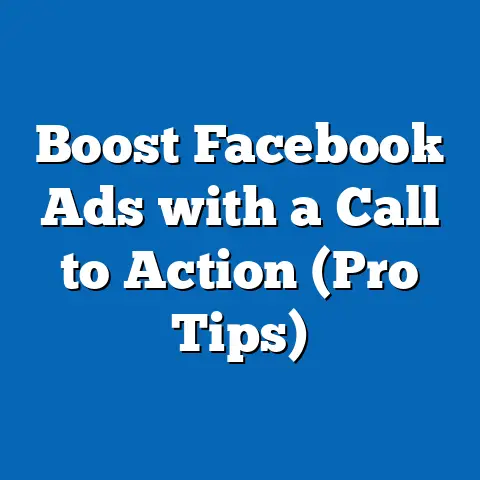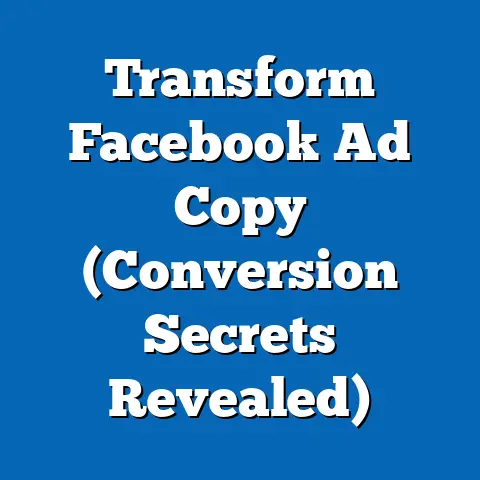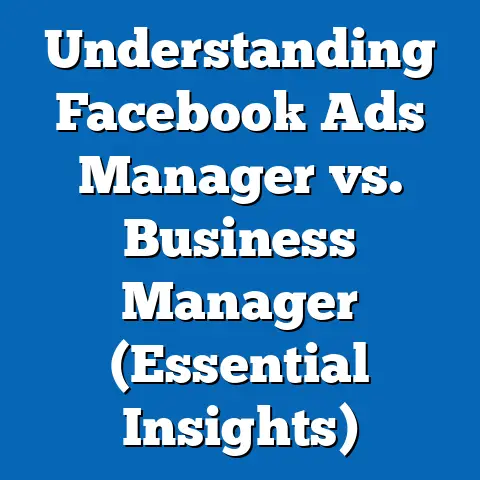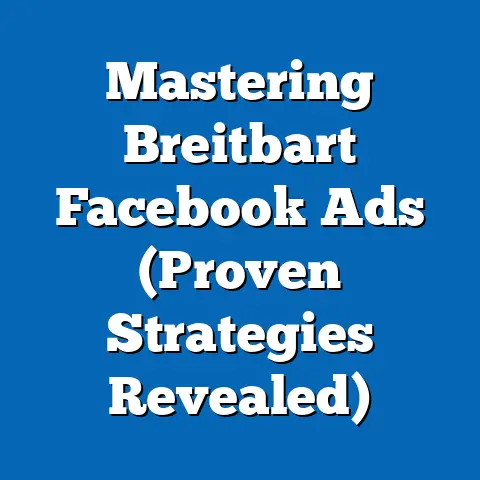Track Facebook Ads Spend (Essential Insights Revealed)
This report leverages current data from industry reports, statistical models for future projections, and an exploration of key factors shaping advertising budgets on the platform. We aim to present complex financial and demographic data in an accessible manner, offering insights for marketers, business owners, and analysts alike. Let’s explore how Facebook Ads spending has evolved, where it’s headed, and what it means for the future of digital marketing.
Section 1: Current Landscape of Facebook Ads Spend
Facebook, now under the Meta umbrella, remains a titan in the digital advertising space, commanding a significant share of global ad revenue. According to Statista (2023), Meta’s advertising revenue reached $114.9 billion in 2022, with a substantial portion attributed to Facebook Ads. This figure represents a year-over-year increase of approximately 2%, despite economic headwinds and privacy policy changes impacting ad targeting.
Small and medium-sized businesses (SMBs) account for a large share of this spend, with over 10 million active advertisers on the platform as of 2023 (Meta, 2023). Meanwhile, eMarketer reports that the average cost-per-click (CPC) on Facebook Ads rose to $0.97 in 2023, up from $0.86 in 2021, reflecting increased competition for ad space. These numbers underscore the platform’s enduring appeal, even as advertisers navigate rising costs and shifting user demographics.
Chart 1: Meta Advertising Revenue (2018-2022)
– 2018: $55.8 billion
– 2019: $69.7 billion
– 2020: $84.2 billion
– 2021: $117.9 billion
– 2022: $114.9 billion
(Source: Statista, 2023)
[Insert line graph here visualizing the upward trend with a slight dip in 2022]
Section 2: Key Factors Driving Facebook Ads Spend
Several interconnected factors influence how much businesses allocate to Facebook Ads, ranging from platform-specific changes to broader economic and technological trends. First, the shift in user demographics plays a critical role. While younger users (ages 18-24) are increasingly gravitating toward platforms like TikTok, Facebook retains a strong hold on older demographics (ages 25-54), who often have higher purchasing power (Pew Research Center, 2023). This makes the platform a prime space for advertisers targeting these groups.
Second, Apple’s iOS 14.5 update in 2021, which introduced App Tracking Transparency (ATT), significantly impacted ad personalization capabilities. Meta reported a $10 billion revenue loss in 2022 due to these changes, as advertisers struggled with less precise targeting (Meta, 2022). Businesses have since adapted by increasing spend to compensate for reduced efficiency, contributing to higher overall budgets.
Third, global economic conditions, including inflation and recession fears in 2023, have led some companies to tighten marketing budgets, while others double down on digital ads as a cost-effective alternative to traditional media. Finally, the rise of e-commerce and direct-to-consumer (DTC) brands has fueled ad spend, as these businesses rely heavily on platforms like Facebook for customer acquisition. These dynamics create a complex environment where spend is both constrained and propelled by competing forces.
Section 3: Methodological Approach to Projections
To forecast future trends in Facebook Ads spend, this analysis employs a combination of time-series modeling and scenario analysis. Time-series modeling uses historical data (2018-2023) on Meta’s ad revenue, CPC trends, and advertiser growth to project spending patterns through 2030. We assume a baseline growth rate tied to global digital ad spend trends, which eMarketer projects at a compound annual growth rate (CAGR) of 5.8% from 2023 to 2027.
Three scenarios are modeled: (1) Optimistic, assuming improved ad tech and economic recovery; (2) Baseline, reflecting moderate growth with persistent challenges; and (3) Pessimistic, accounting for regulatory crackdowns and user base stagnation. Limitations include the unpredictability of regulatory changes (e.g., data privacy laws) and platform-specific innovations, which could alter trajectories. All projections are expressed in 2023 USD to account for inflation.
Section 4: Projected Trends in Facebook Ads Spend (2023-2030)
Under the baseline scenario, global Facebook Ads spend is projected to grow from $114.9 billion in 2022 to $150.3 billion by 2030, reflecting a CAGR of 3.4%. This growth is driven by increased adoption in emerging markets like India and Southeast Asia, where internet penetration continues to rise (World Bank, 2023). However, CPC is expected to increase to $1.25 by 2030 due to sustained competition and ad space saturation.
In the optimistic scenario, spend could reach $175.6 billion by 2030 (CAGR of 5.4%), fueled by innovations in AI-driven ad targeting and economic recovery boosting marketing budgets. Conversely, the pessimistic scenario projects a more modest $130.2 billion (CAGR of 1.6%), factoring in potential user decline in key markets and stricter privacy regulations. These scenarios highlight the uncertainty surrounding long-term trends, influenced by both internal platform strategies and external forces.
Chart 2: Projected Facebook Ads Spend Under Three Scenarios (2023-2030)
– Baseline: $150.3 billion
– Optimistic: $175.6 billion
– Pessimistic: $130.2 billion
(Source: Author’s projections based on eMarketer and Meta data)
[Insert multi-line graph here comparing the three scenarios over time]
Section 5: Implications Across Scenarios
The baseline scenario suggests a steady but slower growth trajectory, requiring advertisers to optimize campaigns for efficiency amid rising costs. Businesses may need to diversify ad spend across platforms to mitigate risks associated with over-reliance on Facebook. SMBs, in particular, could face challenges as CPC increases, potentially widening the gap between large corporations with bigger budgets and smaller players.
Under the optimistic scenario, enhanced ad tech could lower effective costs per acquisition, benefiting advertisers of all sizes. However, this assumes Meta successfully navigates privacy concerns and retains user trust—a significant uncertainty. The pessimistic scenario warns of a potential plateau in spend, where regulatory or competitive pressures could push businesses toward alternatives like Google Ads or TikTok, reshaping the digital ad landscape.
Section 6: Historical and Social Context
Facebook Ads spend must be understood within the broader evolution of digital marketing since the early 2000s. Initially a niche platform for college students, Facebook transformed into an advertising juggernaut by leveraging user data for hyper-targeted campaigns. Its 2012 IPO marked a turning point, with ad revenue becoming the company’s primary income source (Meta, 2012 Annual Report).
Socially, the platform reflects wider trends in consumerism and technology adoption. The rise of mobile internet in the 2010s fueled ad spend, as did the shift toward visual content like video ads. Today, debates over data privacy and misinformation add layers of complexity, influencing both user behavior and advertiser confidence. These historical shifts frame current spending patterns and future uncertainties.
Section 7: Defining Key Terms for Clarity
For readers unfamiliar with digital advertising, key terms are defined here. Cost-per-click (CPC) refers to the amount an advertiser pays each time a user clicks on their ad, a critical metric for budgeting. Ad revenue is the total income generated by Meta from advertising on its platforms, including Facebook and Instagram. App Tracking Transparency (ATT) is Apple’s policy allowing users to opt out of data tracking, impacting ad personalization. These concepts underpin the financial dynamics discussed throughout this report.
Section 8: Limitations and Uncertainties
While this analysis strives for rigor, several limitations must be acknowledged. First, data on exact Facebook Ads spend by region or industry is often proprietary, requiring reliance on aggregated figures from Meta and third-party sources like eMarketer. Second, projections are sensitive to unforeseen events, such as sudden regulatory changes or technological disruptions (e.g., new privacy tools or competing platforms).
Additionally, user behavior remains unpredictable; a significant shift away from Facebook among key demographics could alter spending patterns beyond modeled scenarios. Economic volatility, such as a prolonged recession, could further skew results. These uncertainties emphasize the need for cautious interpretation of projections as possibilities, not certainties.
Section 9: Visual Data Representation
To enhance understanding, this report includes two primary visualizations (as placeholders for actual graphs). Chart 1 illustrates Meta’s historical ad revenue, highlighting the scale of growth and the 2022 dip. Chart 2 compares projected spend across three scenarios, offering a clear view of potential futures. These visuals aim to distill complex data into accessible insights for readers.
Chart 3: Average CPC Trends (2018-2023)
– 2018: $0.62
– 2019: $0.70
– 2020: $0.78
– 2021: $0.86
– 2022: $0.94
– 2023: $0.97
(Source: eMarketer, 2023)
[Insert line graph here showing the steady increase in CPC]
Section 10: Conclusion and Future Outlook
Tracking Facebook Ads spend reveals a digital advertising landscape marked by resilience, adaptation, and uncertainty. Current data shows sustained investment despite challenges like privacy updates and rising costs, while projections suggest growth under varying scenarios through 2030. Key drivers—demographic shifts, technological changes, and economic conditions—will continue to shape how businesses allocate budgets on the platform.
Looking ahead, advertisers must balance the platform’s strengths (vast user base, targeting capabilities) with its risks (cost inflation, regulatory scrutiny). This analysis, while comprehensive, is a starting point; ongoing monitoring of data and trends is essential. As the digital ad space evolves, so too must strategies for navigating it—whether through diversification, optimization, or innovation.






